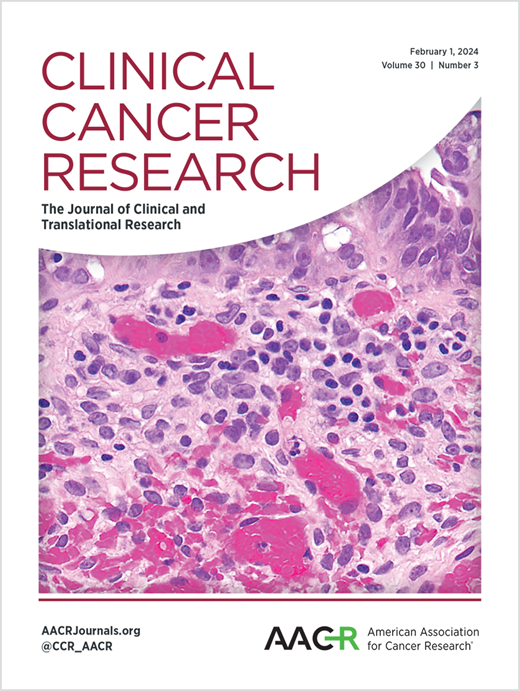Impact of molecular androgen and estrogen response scores on outcomes following neoadjuvant pembrolizumab in muscle-invasive bladder cancer.
IF 10
1区 医学
Q1 ONCOLOGY
引用次数: 0
Abstract
PURPOSE Androgen and estrogen influence bladder cancer pathogenesis, but their role in modulating treatment response, especially immunotherapy, remains unclear. This post-hoc analysis of the PURE-01 trial evaluated the impact of androgen and estrogen signatures on outcomes in muscle-invasive bladder carcinoma patients treated with neoadjuvant pembrolizumab followed by radical cystectomy (RC). PATIENTS AND METHODS Pre-treatment transurethral resection of bladder tumor samples from 102 PURE-01 patients were analyzed using the Decipher Bladder whole-transcriptome assay to classify genomic subtypes. Hallmark androgen response (ARS), early estrogen response (ERS-early), and late estrogen response (ERS-late) scores were derived and visualized with boxplots. Subgroup differences were assessed using Mann-Whitney U, chi-squared, and Kruskal-Wallis tests. Event-free survival (EFS) was the primary endpoint, while pathological response was the secondary endpoint. Cox proportional hazard models and Kaplan-Meier analyses evaluated the association of molecular scores with outcomes. Immune 190 and FGFR3 signatures were also analyzed to explore their interactions with ARS and ERS. RESULTS Luminal subtypes had the highest ARS and ERS scores across molecular classifications. Negative correlations were observed between immune190 scores and ERS and ARS scores. ERS-late scores were highest in non-responders and significantly associated with worse EFS. Conversely, ARS was not significantly linked to EFS. FGFR3 signature positively correlated with ARS and ERS, and negatively with immune190 scores. CONCLUSIONS The strong association of ERS-late scores with both pathological response and EFS suggests this signature could guide patient stratification and treatment selection. These findings support future trials combining immunotherapy with anti-estrogens, in both neoadjuvant and advanced urothelial carcinoma settings.分子雄激素和雌激素反应评分对新辅助派姆单抗治疗肌肉浸润性膀胱癌后预后的影响。
目的雄激素和雌激素影响膀胱癌的发病机制,但它们在调节治疗反应,特别是免疫治疗中的作用尚不清楚。这项PURE-01试验的事后分析评估了雄激素和雌激素特征对肌肉浸润性膀胱癌患者接受新辅助派姆单抗治疗后根治性膀胱切除术(RC)结局的影响。患者和方法对102例PURE-01患者经尿道膀胱肿瘤切除治疗前的样本进行分析,使用Decipher膀胱全转录组分析对基因组亚型进行分类。Hallmark雄激素反应(ARS)、早期雌激素反应(ERS-early)和晚期雌激素反应(ERS-late)评分得到并以箱线图显示。采用Mann-Whitney U检验、卡方检验和Kruskal-Wallis检验评估亚组差异。无事件生存期(EFS)是主要终点,而病理反应是次要终点。Cox比例风险模型和Kaplan-Meier分析评估了分子评分与预后的关系。还分析了免疫190和FGFR3特征,以探索它们与ARS和ERS的相互作用。结果在分子分类中,肿瘤亚型的ARS和ERS评分最高。免疫190评分与ERS和ARS评分呈负相关。无应答者的ERS-late评分最高,且与较差的EFS显著相关。相反,ARS与EFS无显著相关性。FGFR3特征与ARS和ERS呈正相关,与免疫190评分呈负相关。结论ERS-late评分与病理反应和EFS有较强的相关性,提示该特征可指导患者分层和治疗选择。这些发现支持未来在新辅助治疗和晚期尿路上皮癌中联合免疫治疗和抗雌激素治疗的试验。
本文章由计算机程序翻译,如有差异,请以英文原文为准。
求助全文
约1分钟内获得全文
求助全文
来源期刊

Clinical Cancer Research
医学-肿瘤学
CiteScore
20.10
自引率
1.70%
发文量
1207
审稿时长
2.1 months
期刊介绍:
Clinical Cancer Research is a journal focusing on groundbreaking research in cancer, specifically in the areas where the laboratory and the clinic intersect. Our primary interest lies in clinical trials that investigate novel treatments, accompanied by research on pharmacology, molecular alterations, and biomarkers that can predict response or resistance to these treatments. Furthermore, we prioritize laboratory and animal studies that explore new drugs and targeted agents with the potential to advance to clinical trials. We also encourage research on targetable mechanisms of cancer development, progression, and metastasis.
 求助内容:
求助内容: 应助结果提醒方式:
应助结果提醒方式:


